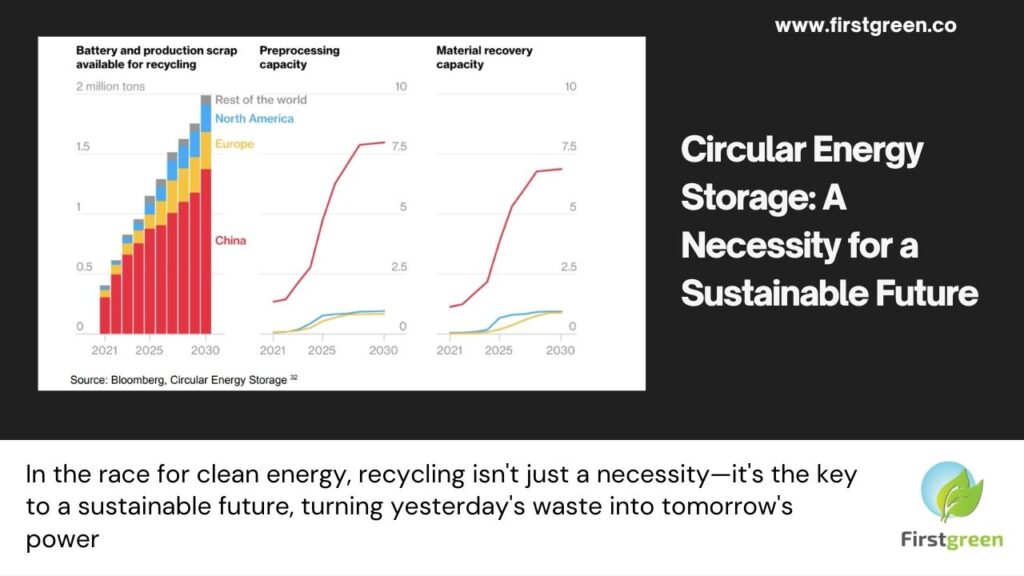
In the rapidly evolving landscape of clean energy, the concept of circular energy storage has emerged as a cornerstone for sustainability. “The more we expand our clean energy capabilities, the greater the need to close the loop with effective recycling strategies,” says energy expert Matt Pollard. This principle is at the heart of China’s global dominance in battery recycling, setting a benchmark for other nations, including India, as they strive to manage the environmental impact of their burgeoning electric vehicle (EV) industries.
China’s Command in Global Battery Recycling
China’s rise as a global leader in battery recycling is no accident. It is the result of a strategic alignment of government policies, corporate initiatives, and technological innovation. The Chinese government, recognizing the environmental and economic imperatives of recycling, has implemented stringent policies that mandate auto manufacturers to establish collection and recycling facilities for end-of-life batteries. This policy framework has not only propelled China to the forefront of battery recycling but has also solidified its dominance in the global clean energy market.
The Importance of Battery Recycling
Battery recycling is critical for several reasons. First, it reduces the demand for virgin raw materials, many of which are finite and concentrated in geopolitically sensitive regions. Recycling helps in recovering valuable materials like lithium, cobalt, and nickel, which can be reused in new batteries, thereby reducing the environmental impact of mining and refining. Second, recycling mitigates the environmental hazards associated with the disposal of used batteries, which contain toxic substances that can leach into soil and water. Finally, as the demand for batteries grows, especially with the global shift towards electric vehicles, recycling becomes essential to ensure a sustainable supply of battery components.
Government Policies in China
China’s government has taken a proactive approach to battery recycling, implementing policies that require manufacturers to be responsible for the entire lifecycle of their products. Since 2018, Chinese auto manufacturers have been mandated to establish collection and recycling facilities for end-of-life batteries. This extended producer responsibility (EPR) framework ensures that manufacturers like BYD and CATL are not only focusing on production but also on the sustainable management of batteries once they reach the end of their useful life.
BYD and CATL: Pioneers in Battery Recycling
BYD and CATL, two of China’s leading EV and battery manufacturers, have set up extensive recycling networks to comply with government regulations and to ensure the sustainability of their operations. BYD, for instance, has integrated recycling into its production process, allowing it to recover and reuse materials from spent batteries. Similarly, CATL, through its subsidiary Brunp Recycling, has developed state-of-the-art facilities that can recover up to 99.6% of valuable metals from used batteries. These efforts not only help in reducing waste but also in lowering the costs of battery production by reusing recycled materials.
The Indian Context: A Growing Need for Battery Recycling
India, one of the fastest-growing EV markets, is witnessing an exponential increase in the adoption of electric two-wheelers and four-wheelers. In 2023 alone, India added approximately 1.5 million electric two-wheelers and 200,000 electric four-wheelers to its roads. This rapid growth underscores the urgent need for robust battery recycling infrastructure in the country.
However, India’s battery recycling efforts are still in their nascent stages. Unlike China, India lacks comprehensive government policies mandating battery recycling by manufacturers. This gap presents a significant challenge as the volume of end-of-life batteries is expected to rise sharply in the coming years. According to Bloomberg, the availability of battery production scraps and used batteries suitable for recycling is projected to quadruple by 2030 in India. To address this, the Indian government must push electric vehicle manufacturers to establish and scale up recycling facilities.
Indian Manufacturers and Battery Recycling Initiatives
Despite the absence of stringent regulations, some Indian manufacturers are beginning to take steps toward battery recycling. The Mahindra Group, a key player in India’s EV market, has initiated programs to recycle batteries used in their electric vehicles. Similarly, Tata Motors has partnered with recycling companies to ensure that their batteries are repurposed or recycled at the end of their lifecycle. These initiatives are promising, but there is still a long way to go before India can match China’s scale and efficiency in battery recycling.
The Path Forward: Learning from China’s Success
For India to develop a robust battery recycling ecosystem, it can learn valuable lessons from China’s experience. The Indian government should consider implementing policies that mandate manufacturers to take responsibility for recycling their products. Additionally, fostering partnerships between public and private sectors can help in scaling up the necessary infrastructure. With the right policies and industry initiatives, India can not only manage the environmental impact of its growing EV market but also position itself as a leader in the global clean energy transition.
In conclusion, as the world moves towards a more sustainable future, circular energy storage and battery recycling will become increasingly crucial. China’s dominance in this field offers a roadmap for other countries, including India, to follow. By prioritizing recycling, we can ensure that the benefits of clean energy are fully realized, without compromising the health of our planet.